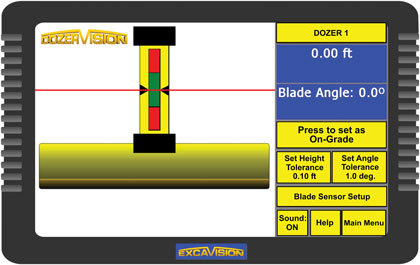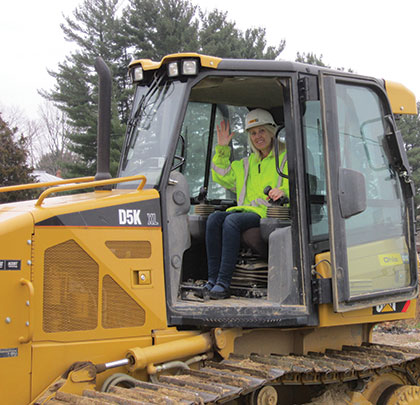An explosion of time-saving electronic devices for the construction industry has occurred in the last 30 years or so. These gadgets increase machine productivity so much that they pay for themselves in a very short time. The early 70’s saw the birth of the rotating laser, invented by Laserplane of Ohio in Dayton, Ohio. It revolutionized the process of measuring depths on a construction site. However, the popularity of the rotating laser grew very slowly. It took most of the 80’s for it to become a household name with contractors. Initially, contractors just used a rotating laser and a rod-mounted laser receiver to measure the depth of excavations.
GRADE CONTROL ON BULLDOZERS
Bulldozers were the first earth-moving machines to get laser-guided grade control. Initially, the system was “indicate only.” In that scenario, the operator watched the lights on a laser receiver mounted on the bulldozer’s blade and controlled the height and lateral slope of the blade. Full automation came years later, where the laser receiver on the dozer’s blade was used to control the hydraulics on the bulldozer. The installation of such system was difficult, but once in place it brought tremendous advantages.
GRADE CONTROL ON EXCAVATORS
It took much longer to develop grade control for excavators because it was hard to install sensors to measure the position of the boom, stick, and bucket, and thus find the digging depth. Several products and inventions were tried; most of them were too complicated for practical use. The first excavator depth monitor using inclinometers on the excavator’s arms came out in 1992 from Ocala Instruments in Florida. Almost all excavator depth monitors today use that same principle. The original device in 1992 was an “indicate only” system; it was based on sensors (inclinometers) on the excavator’s arms. The sensors were connected by cables into the display in the cab and a computer calculated the depth of the tip of the bucket. Connecting the sensors with cables into the cab was a tedious job. Some manufacturers, for example AGL and ExcaVision, have therefore opted for wireless sensors, making installation much easier and quicker. The first attempt to automate the digging process on excavators was made by Topcon (System 5). The operator only had to pull in the stick and the system controlled the boom and bucket through the hydraulics, rendering a smooth bottom. The problem here was similar to the bulldozer’s implementation; the system was too difficult to install and adjust, so its production was discontinued. Just a few weeks ago, Komatsu launched a semi-automatic system on its PC210i-10. It is a very promising system; however, the price is prohibitive, adding about $100,000 to the price tag of the excavator.

ExcaVision’s “DozerVision” makes grade control easier, increasing productivity.
GPS ON EARTH-MOVING MACHINES
The GPS (Global Positioning System) is gaining popularity, replacing the rotating laser as a grade reference. The advantage is that one can monitor the whole jobsite on the display (3D) and work from engineering drawings. It is particularly useful when working on large development sites and contouring golf courses. The issue with GPS is that a system for grade control is much more expensive than a laser-based system and impossible to get the same reliable accuracy as from a laser light. A car navigation system and most smartphones have built-in GPS, but the accuracy is not good enough for grade control in the construction industry.
Contractors often own several machines, such as a backhoe, a track hoe, or a dozer. They may not have an operator for each machine. Investing in grade control for each machine would be costly, so an ideal system would be one that could be used on all machines.
FROM THE FIELD
Chuck Daiber of Daiber Excavating & Trucking in Nevada, Ohio, is one of the first contractors to use a wireless excavator depth monitor.
“Back in 2001, I bought the OC7wl excavator depth monitor from Ocala Instruments. After 11 years of use, I got the ExcaVision system. ExcaVision is much nicer because it is very easy to use, much faster, and has a touch screen display with a whole lot of features that the old OC7wl didn’t have. I use the same system on all my equipment, which consists of three track hoes, a dozer, a scraper, a Galion road grader, and a smaller Galion. It takes just a couple of minutes to move it from one machine to another, so no delays there. And I still use my 14-year-old OC7wl on one of my track hoes, so these things are pretty durable.”
Chucks continues: “My helper Jane has worked with me for years. She used to be on the laser rod all day, not very productive. She graduated to operator a long time ago and uses ExcaVision on the dozer. So over the years, grade control has saved me a lot on wages and the digging is perfect the first time—no more redoing work.”
The bottom line is that grade control systems pay for themselves in a short time, make life easier, and increase production. ■
About The Author:
Kristjan Ingvarsson is the president of ExcaVision, Inc., based in Orlando, Florida. For more than 20 years, the ExcaVision team has specialized in grade control for excavators, bulldozers, and other earth-moving equipment and attachments. For more information, visit www.excavision.com.
_________________________________________________________________________
Modern Contractor Solutions, February 2015
Did you enjoy this article?
Subscribe to the FREE Digital Edition of Modern Contractor Solutions magazine.

The Evolution of Accuracy


